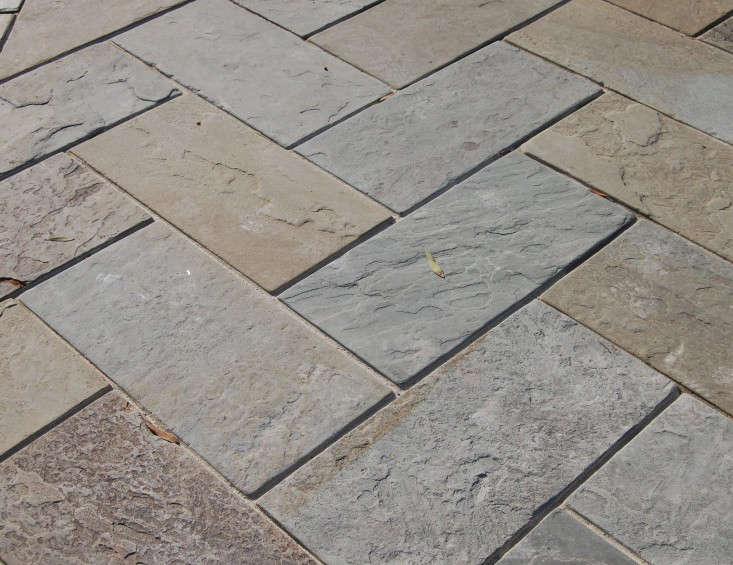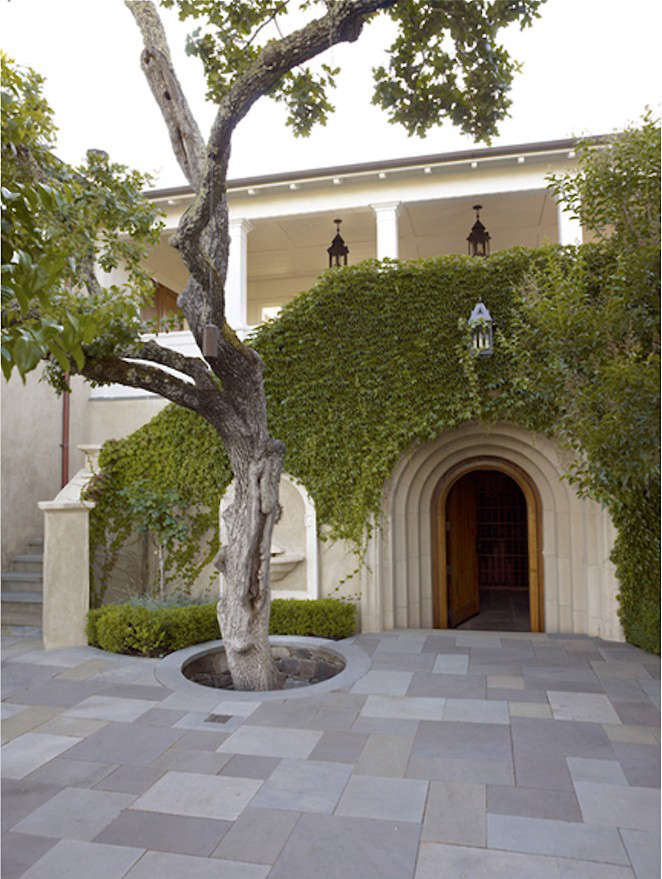While I was in the midst of a major home construction project and feeling pretty good about some of my recent design decisions, the stonemason arrived and asked how I’d like the bluestone deck to look. “There are choices?” I asked.
Until that moment I hadn’t realized there were a number of details to consider, such as color, pattern, texture, and edging. Somewhat panicked and hoping to buy time, I took a crash course in Pennsylvania bluestone so I could make informed decisions. Is bluestone the right material for your hardscaping project? Here’s what I learned.

What is Pennsylvania bluestone?
Pennsylvania bluestone is a dense, strong, fine-grained sandstone quarried in the northeastern United States, mostly in Pennsylvania and upstate New York. It is an excellent material for decks and patios as it resists cracking and won’t discolor. It easily can be separated into slabs of varying sizes, making it suitable for other architectural details such as steps, walls, building facades, interior floors, and fireplaces.
Bluestone has a distinctive hard-yet-soft quality that makes it very appealing. Its texture is rough enough to provide traction in the rain, yet it’s smooth and soft enough to lie upon and bask in the sun.
What colors and textures are available?
Due to different clays and mineral deposits carried by groundwater during the stone’s formation, Pennsylvania bluestone can vary from its predominantly silvery blue color to any combination of brown, tan, rust, green, and lilac. Full range color encompasses all shades. For a more even effect, select blue or blue-blue includes variations of the silvery blue color only.
There are two choices of texture: natural cleft or sawn thermal. A natural cleft surface is created when blocks of bluestone are sawn out of the ground and split on visible seams. The surface has a natural texture and is non-gauged, which means the thickness is approximate. Curly rippled texture is a variation on natural cleft.


What patterns are available?
There are two general categories of patterns used for bluestone patios: An ashlar pattern combines squares, rectangles, and color variations, and a fieldstone pattern joins irregular shapes together in a random pattern.





What are some design considerations when planning a deck or patio?
The first thing to consider is location: Is your deck or patio raised or at ground level, attached to the house or set farther away in a more natural setting? If the patio is at ground level, you have the option of having it set in sand rather than mortar. Sand-set stone has the advantage of being permeable, but can also allow shifting, which may cause it to become uneven over the years, especially if your area has gophers that can burrow beneath (though measures can be taken during installation to prevent this).
If you’re planning a raised deck and the edges will be visible, you may want to put some thought into the texture and thickness of the edge. A chiseled or tumbled edge will achieve a softer look. If your style is more tailored, you may opt for a thermaled edge. I chose an edge that was thicker than the field pavers (two inches rather than one inch) to make the deck appear more substantial. This was achieved by creating a 12-by-18-inch-wide border (two inches thick) set one inch below the level of the field pavers.
This extra inch of thickness, as well as a slope for surface water drainage (figure a quarter of an inch per foot), needs to be planned for at the earliest design stages while setting the level of the deck.
How do you clean and maintain bluestone?
One of the great things about Pennsylvania bluestone is that it does not need to be sealed, and it can be cleaned easily with a soft scrub brush and water. Vinegar or lemon diluted in water can be used for tougher stains. Every few years, you may wish to power wash your bluestone deck. If you do, please don’t repeat the mistake we made when we power washed the deck on the strongest setting, using a concentrated spray that left swirling lines visible on the stone (though at least it was clean). No amount of scrubbing could fix the issue and it stayed this way for a year until a helpful handyman suggested power washing it again, this time on the correct setting. Problem fixed.
Efflorescence is a powdery white substance that can appear on the surface a few years after your bluestone is installed. This cosmetic problem is not unique to bluestone. It can occur in many masonry products and can be prevented by using certain additives in the mortar (it’s a good issue to discuss with your contractor).
How much does Pennsylvania bluestone cost?
Pennsylvania bluestone costs from $16 to $26 per square foot installed. Factors affecting price include the area where you live, the pattern, thickness, and any special fabrication.
Pennsylvania bluestone recap:
Pros:
- Flexible applications: can be used both indoors and out on a wide variety of surfaces.
- Hard surface yet soft feel.
- Versatile style: can be used in both modern and traditional spaces.
- Requires little maintenance.
Cons:
- Limited color options: blue/gray predominate.
- More expensive than other deck materials such as wood.
- Is thicker than many other deck/patio materials (which can be an issue with clearance below doors).
- Does not adhere well to mortar alone: requires a thinset.

Ready to embark on a remodel of your own? Start with our curated Hardscape 101 design guides for Decks & Patios 101, Pavers 101, and Driveways 101. Read more:
- Hardscaping 101: Poured-in-Place Concrete
- 10 Easy Pieces: Patio Pavers
- Hardscaping 101: Designing a Front Path
- 10 Mistakes to Avoid When You Remodel
- Hardscaping 101: Ground Covers to Plant Between Pavers












Have a Question or Comment About This Post?
Join the conversation (2)